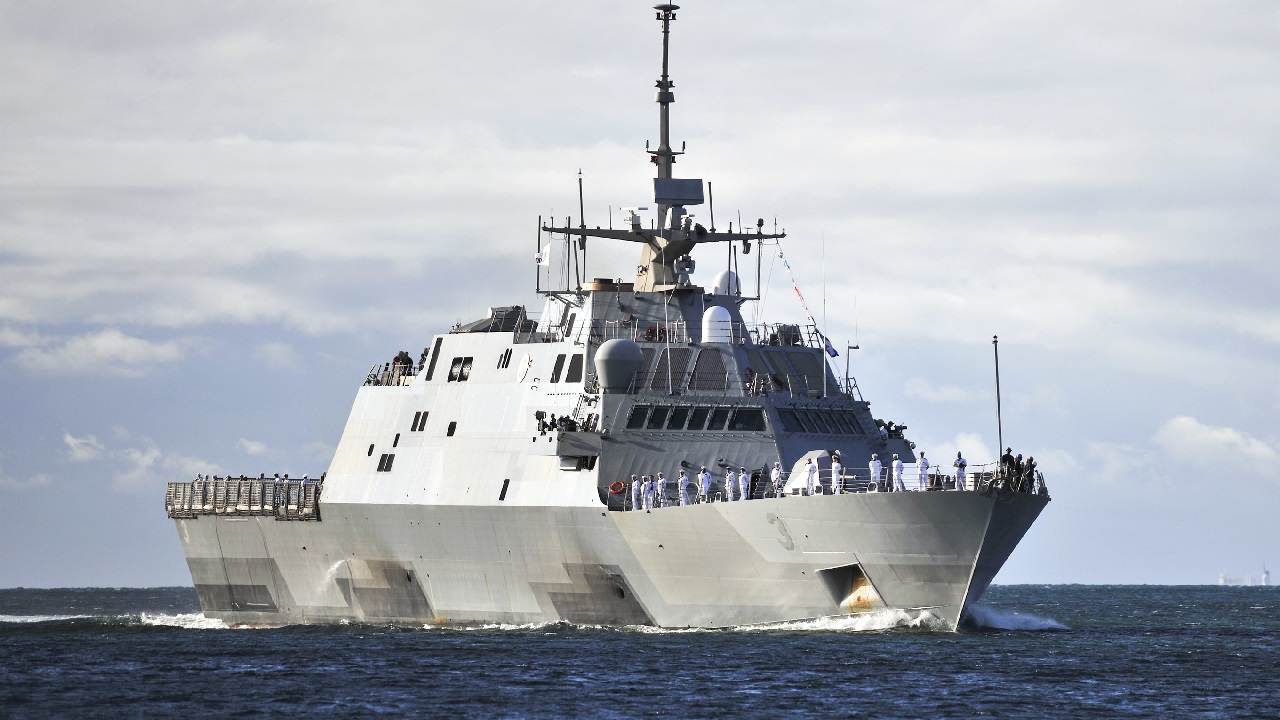This past weekend, the U.S. Navy launched the future USS Cleveland (LCS-31) at a ceremony in Marinette, Wisconsin. It was a notable event in more ways than one. First because the event marked the 16th and final Freedom-class littoral combat ship that will be delivered to the U.S. Navy. It also became the final vessel to slide sideways down a ramp into the waters of the Menominee River.
All subsequent launches at the site will utilize a shiplift system, replacing a millennia-old launch technique.
“It’s an end of an era, these side launches are visibly spectacular and they’re a lot of fun to do,” said Fincantieri Marinette Chief Executive Officer Mark Vandroff. “It’s the way people have put ships into the water for literally thousands of years — with basically the same technology. We’re a modern shipyard and we have to adapt to the way of the future.”
Cleveland Christened
The ship’s sponsor, Robyn Modly — wife of former Acting Secretary of the Navy Thomas B. Modly — christened the ship shortly before 11:30 a.m. with a successful swing of a sparkling wine bottle on the bow. About 3,000 invited guests, including dignitaries, shipyard officials, employees, retirees, the ship’s assigned crew, and other Navy personnel,were gathered at the shipyard. The weather, near summer-like, made the event all the more special.
Despite being just 387 feet long and weighing 3,500 metric tons, building the vessel required a great effort, said Vandroff. Though the ship is now floating in the Menominee River, it will still require a year’s worth of further work before it is delivered to the U.S. Navy.
“It was a million hours of effort…to get Cleveland from just being pieces of steel, to what you see behind you,” Vandroff noted during Saturday’s launch event.
The event was also not without incident – almost fitting given the history of the LCS program. According to reports, the Navy’s brand-new vessel newly collided with a tugboat during the launch.
Littoral Combat Ship: A Less Crappy Little Ship?
For many naval officials, the launch event of the final Littoral Combat Ship likely wasn’t a sad moment. The service has already poured billions of dollars into the program, yet, the ships have been riddled with problems for years.
The LCS was developed during the Global War on Terror, and the fast and agile vessels were envisioned to serve as stealthy surface combatants capable of defeating anti-access missile-firing boats, small submarines, and other asymmetric threats in littoral or near-shore waters. They now seem entirely ill-suited to a conflict with a near-peer adversary such as China or Russia. With shifting priorities, not to mention the fact that the LCS program failed to deliver on its promised potential, the U.S. Navy has already retired a number of the small but fast-moving vessels.
The LCS concept was meant to emphasize speed, allow flexible mission modules, and operate where larger warships couldn’t. All of that sounded good, but in practice the ships have been prone to breakdowns and defects. According to some accounts, the LCSs came to be known as the “Little Crappy Ships” by some U.S. Navy sailors.
In addition, the LCSs simply didn’t fit the long-term makeup of the U.S. Navy fleet, which will still consist of aircraft carriers, destroyers, and other surface combatants that have been around for decades.
Congress also cut funding from the mission modules and this left the U.S. Navy with small and fast ships that really aren’t up to the task in the changing geopolitical world.
There have been calls from some officials to gift them a South American partner, as the vessels have proven well-suited in a drug interdiction role, but seemingly little else.
It is unclear if the future USS Cleveland has addressed some of the issues. Moreover, the LCS program could still serve a role in waters such as the South China Sea. In the grand scheme of things, this is a program that simply didn’t work out as planned.
Honoring C-Town
LCS-31 will be the fourth U.S. Navy vessel named in honor of Ohio’s second-largest city. The first was the USS Cleveland (C-19), a protected cruiser that was commissioned in 1903 and was only decommissioned in 1929.
The second was CL-55, the lead ship of the Cleveland class of light cruisers built during and after the Second World War. A total of 57 were planned, while 27 were completed — along with nine that were converted to light aircraft carriers. During the war, the USS Cleveland (CL-55) saw deployments to North Africa and then to the Pacific. In addition to a Navy Unit Commendation for service at the Battle of Empress Augusta Bay, the Cleveland received 13 battle stars for World War II service. She was placed out of commission after World War II and sold for scrap in 1960.
The most recent USS Cleveland was LPD-7, an amphibious transport dock that was commissioned in 1967 and decommissioned in 2011. In her 44 years of service, the USS Cleveland (LPD-7) received numerous awards, including two Combat Action Ribbons and 23 Vietnam Service Medals.
The future LCS-31 will have a strong legacy to maintain.
MORE: Video – Ukraine Has Massive New NATO ‘Cannon’ Ready To Fight Russia
MORE: ‘Americans Will Pay The Price’: One Democrat Is Angry At Joe Biden
MORE: Could Joe Biden Get Impeached?
Author Experience and Expertise: A Senior Editor for 19FortyFive, Peter Suciu is a Michigan-based writer. He hascontributed to more than four dozen magazines, newspapers, and websites with over 3,200 published pieces over a twenty-year career in journalism. He regularly writes about military hardware, firearms history, cybersecurity, politics, and international affairs. Peter is also aContributing Writer for Forbes andClearance Jobs. You can follow him on Twitter:@PeterSuciu.

